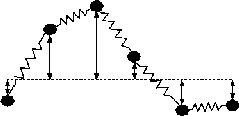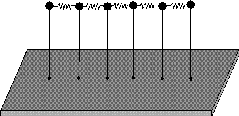System Description
We investigate the dynamics of an unstable array of mass points that are connected
by springs, while applying different kinds of control stratgeies. We call our
model system the unstable chain but the equations of motion cover a broad class
of unstable systems that are close enough to their unstable fixpoint, so a
linearized description of the dynamics is a reasonable approach for small
displacements.
The left picture shows the basic idea of the system. It consists of n mass
points that are connected by (n-1) springs to each other. As boundary condition,
that is not shown in the picture, the two mass points at the end of the chain
are connected to a wall so there are (n+1) springs in the system. Mass points
can only move in one dimension in our model. The overall force on each mass
point is given by the two nearest neighbor spring forces, a displacement
proportional force that causes the system's instability and a control force
produced by an actuator that is attached to the mass point.
Another interpretation of this system is a chain of pendulums as
shown in the right picture above. The unstable fixpoint of that system is given
by all mass points pointing upwards. The forces that push a single pendulum away
from its unstable fixpoint are proportional to the displacement (the angle in
this case) if the displacement is small. Our model system is also motivated by
the scenario of a buckling beam where the buckling forces are proportional to
the displacement.
In analogy to multiagent systems we define agents, problems and hints.
- Agents: mass points that carry a sensor, an actuator and a computational
unit.
- Global problem: control the unstable system.
- Local problems: keep the local displacements small.
- Hints: displacement information from other agents.
We use a continuous differential equation solver (predictor-corrector) in our
simulations. The chain's dynamics is given by the physical equations of motion
in which the control force term is based on agents decisions. Our control term
is a linear combination of all agents displacements. The weighing factors
corresponds to how important an agent considers displacement information from
another agent. The set of weighing factors form the interaction matrix that
represents the organizational structure underlying the control proccess.
last changed: July 31,1997
Oliver Guenther



